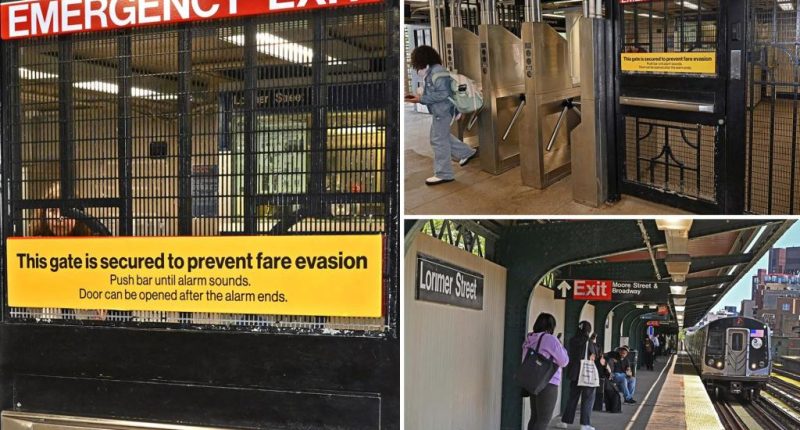
The MTA has gone off the rails with its fare evasion crackdown, critics say.
The agency’s latest attempt at thwarting fare evaders is to bolster a program that locks subway emergency gates for 15 seconds after they’re opened, in a bid to stop scofflaws from sneaking in without paying.
But riders could still hold the doors open for fare beaters even under the pilot program, which the Metropolitan Transportation Authority announced Monday it was expanding to at least 150 stations this year.
Some straphangers pointed out the initiative could be dangerously foolish and spark mass panic in case of an emergency, such as a fire or shooting — and ripped it as un-fare to those with disabilities.
“When you’re in a state of panic and need to get out of a place fast, that 15-second [delay] is a long time,” said Sharon McLennon-Wier, executive director of the Center for Independence of the Disabled New York.
Dustin Jones, a disability advocate who uses a wheelchair and who sued the MTA in 2017 over alleged accessibility issues at subway stations, agreed, calling the program “very dangerous.”
“The average person with a disability, if they are moving slowly and they have to wait for a certain time for the door to open, that’s time that you’re losing — [and] in an emergency, every second counts,” Jones told The Post.
News of the expanded fare-beating bid comes after the MTA said the issue was at “crisis-level” in a Blue-Ribbon Panel report released last year – which found turnstile hoppers cost the agency $690 million in 2022 alone.
“Every dollar lost to evasion impairs the MTA’s financial stability, threatens reliable transit for all New Yorkers, and increases the need for alternative revenue sources, including through larger fare and toll hikes,” the report reads.
The MTA did not respond to multiple inquiries from The Post about what riders should do during an actual emergency if they are forced to wait to exit through the safety gates.
But the agency has been given clearance for all applicable fire codes to deploy the measure at existing locations, amNewYork reported.
The next round of alterations to emergency gates — historically used as a “superhighway” for fare evasion — will be implemented later this year in 34 St-Penn Station, Canal St, 161 St-Yankee Stadium, and Jay St-MetroTech, the MTA said in a statement.
The delays have so far been deployed at over 70 stations – including the Lorimer Street J/M train and 59th Street-Lexington Avenue in Manhattan – resulting in a roughly 40% reduction in gate evasion and a 10% drop in fare beating across the entire system, the MTA said.
Some straphangers said it wasn’t worth the risk.
“I think it’s a bad idea,” 68-year-old Bernice Parks told The Post. “Can you imagine if there’s a track fire and there’s smoke and everyone comes rushing up to the door trying to get out?
“It might slow down the [fare beaters],” the Williamsburg, Brooklyn resident added, “but I don’t think it’s worth putting people’s lives at risk.”
Tony Morris, 57, also a Williamsburg resident, said he didn’t think it would do much to stop kids from turnstile jumping.
“Maybe if the MTA starts making their money back, they’ll stop raising fares every other week,” he griped, while adding, “I’m not too concerned it’ll be a safety issue. You just have to wait a few extra seconds for it to open.”
Sol Lipschutz, 53, agreed that the initiative wouldn’t pose that much of a hazard, saying, “The door is really just meant to be used in emergencies, and I’m not too worried about an emergency in the subway station.
“If there’s an emergency I’ll worry about it then.”
Another Williamsburg local, Wolf Mandelstam, 40, said it was worth a try to curb the fare-beating scourge.
“I’m happy about it,” he said. “I’m tired watching people cheat the fare all the time while the rest of us pay.”
Other MTA efforts to curb fare evasion on subways have included gate guards deployed at 200-plus stations, sleeves and fins installed on turnstile arms, turnstiles modified to prevent jumpers via “back-cocking” and a specialized “EAGLE” enforcement team aboard certain buses.
As a result of the measures, fare evasion dropped 26% in the second half of 2024, the MTA said.
At the same time, the NYPD also issued 143,100 summonses for subway fare evasion in 2024, marking a 96% increase from 2019.
More interventions are expected later this year, including “back-cocking” modifications for the rest of the MTA’s turnstiles and new “wide-aisle” fare gates at 20 stations across the city.
The fare gates, which will be installed starting this fall, will be tested in four different models by four vendors — and are expected to be in at least 150 stations systemwide by 2029.
The pilot stations include Atlantic Av-Barclays Ctr; 14 St-Union Square; 42 St-Port Authority Bus Terminal; Delancey St-Essex St; Nostrand Av; Crown Heights-Utica Av; Jackson Heights-Roosevelt Av; and Forest Hills-71 Av.
“Fare evasion undermines the very system that moves New York City and provides essential transportation for our communities,” New York City Transit President Demetrius Crichlow said in a statement.
“Our team has made real progress, driving down fare evasion for the first time in years,” Crichlow said. “We will continue to explore all measures and means to ensure fare compliance and sustain a system that is equitable for all.”








